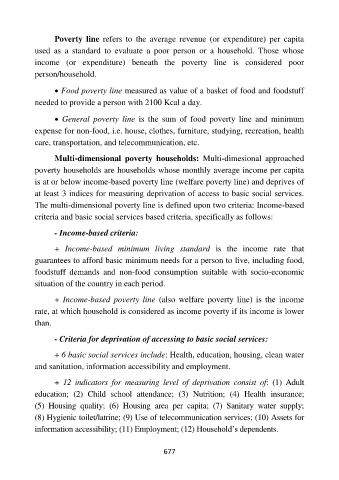Page 677 - index
P. 677
Poverty line refers to the average revenue (or expenditure) per capita
used as a standard to evaluate a poor person or a household. Those whose
income (or expenditure) beneath the poverty line is considered poor
person/household.
Food poverty line measured as value of a basket of food and foodstuff
needed to provide a person with 2100 Kcal a day.
General poverty line is the sum of food poverty line and minimum
expense for non-food, i.e. house, clothes, furniture, studying, recreation, health
care, transportation, and telecommunication, etc.
Multi-dimensional poverty households: Multi-dimesional approached
poverty households are households whose monthly average income per capita
is at or below income-based poverty line (welfare poverty line) and deprives of
at least 3 indices for measuring deprivation of access to basic social services.
The multi-dimensional poverty line is defined upon two criteria: Income-based
criteria and basic social services based criteria, specifically as follows:
- Income-based criteria:
+ Income-based minimum living standard is the income rate that
guarantees to afford basic minimum needs for a person to live, including food,
foodstuff demands and non-food consumption suitable with socio-economic
situation of the country in each period.
+ Income-based poverty line (also welfare poverty line) is the income
rate, at which household is considered as income poverty if its income is lower
than.
- Criteria for deprivation of accessing to basic social services:
+ 6 basic social services include: Health, education, housing, clean water
and sanitation, information accessibility and employment.
+ 12 indicators for measuring level of deprivation consist of: (1) Adult
education; (2) Child school attendance; (3) Nutrition; (4) Health insurance;
(5) Housing quality; (6) Housing area per capita; (7) Sanitary water supply;
(8) Hygienic toilet/latrine; (9) Use of telecommunication services; (10) Assets for
information accessibility; (11) Employment; (12) Household’s dependents.
677

